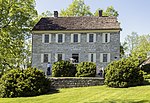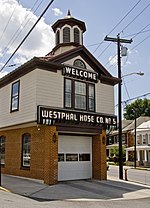Baltimore and Ohio Railroad Martinsburg Shops

Baltimore and Ohio Railroad Martinsburg Shops is a historic industrial district in Martinsburg, West Virginia. It is significant both for its railroading architecture by Albert Fink and John Rudolph Niernsee and for its role in the Great Railroad Strike of 1877. It consists of three contributing buildings, one of which is the oldest covered roundhouse in the United States. The presence of the Baltimore and Ohio Railroad Company in Martinsburg dates back to the late 1840s, when the first engine and machine shops were erected for the expanding company. The shops were designated a National Historic Landmark and placed on the National Register of Historic Places in 2003. They are now managed by a local authority as an event venue.
Excerpt from the Wikipedia article Baltimore and Ohio Railroad Martinsburg Shops (License: CC BY-SA 3.0, Authors, Images).Baltimore and Ohio Railroad Martinsburg Shops
East Martin Street, Martinsburg
Geographical coordinates (GPS) Address Nearby Places Show on map
Geographical coordinates (GPS)
| Latitude | Longitude |
|---|---|
| N 39.459166666667 ° | E -77.96 ° |
Address
East Martin Street
25401 Martinsburg
West Virginia, United States
Open on Google Maps










